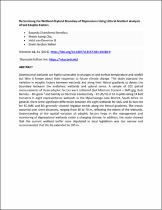 ResearchSpace
ResearchSpace
Determining the wetland-dryland boundary of depressions using littoral gradient analysis of soil edaphic factors
JavaScript is disabled for your browser. Some features of this site may not work without it.
- ResearchSpace
- →
- Research Publications/Outputs
- →
- Journal Articles
- →
- View Item
| dc.contributor.author |
Nondlazi, Basanda X

|
|
| dc.contributor.author |
Cho, Moses A

|
|
| dc.contributor.author |
Van Deventer, Heidi

|
|
| dc.contributor.author |
Sieben, EJ

|
|
| dc.date.accessioned | 2021-08-25T09:26:52Z | |
| dc.date.available | 2021-08-25T09:26:52Z | |
| dc.date.issued | 2021-08 | |
| dc.identifier.citation | Nondlazi, B.X., Cho, M.A., Van Deventer, H. & Sieben, E. 2021. Determining the wetland-dryland boundary of depressions using littoral gradient analysis of soil edaphic factors. <i>Wetlands, 41(81).</i> http://hdl.handle.net/10204/12099 | en_ZA |
| dc.identifier.issn | 0277-5212 | |
| dc.identifier.issn | 1943-6246 | |
| dc.identifier.uri | https://doi.org/10.1007/s13157-021-01430-9 | |
| dc.identifier.uri | http://hdl.handle.net/10204/12099 | |
| dc.description.abstract | Depressional wetlands are highly vulnerable to changes in land surface temperature and rainfall but little is known about their responses to future climate change. This study assessed the variation in edaphic factors between wetlands and along their littoral gradients to detect the boundary between the endorheic wetlands and upland zones. A sample of 202 paired measurements of three edaphic factors were collected (Soil Moisture Content – SMC-g/g, Bulk Density – BD-g/cm 3 and Salinity as Electrical Conductivity – EC-dS/m) in 10 m plots along 14 belt transects in eight representative wetlands in the Mpumalanga Lake District, South Africa. In general, there were significant differences between the eight wetlands for SMC and BD but not for EC.SMC and BD generally showed negative trends along the littoral gradients. The trends occurred over short distances, ranging from 30 to 70 m, reflecting the extent of the wetlands. Understanding of the spatial variation of edaphic factors helps in the management and monitoring of depressional wetlands under a changing climate. In addition, the study showed that the current wetland buffer zone stipulated in local legislation was too narrow and recommended that this be extended to 100 m. | en_US |
| dc.format | Abstract | en_US |
| dc.language.iso | en | en_US |
| dc.relation.uri | https://rdcu.be/cvZiu | en_US |
| dc.relation.uri | https://link.springer.com/article/10.1007/s13157-021-01430-9 | en_US |
| dc.source | Wetlands, 41(81) | en_US |
| dc.title | Determining the wetland-dryland boundary of depressions using littoral gradient analysis of soil edaphic factors | en_US |
| dc.type | Article | en_US |
| dc.description.pages | 14pp | en_US |
| dc.description.note | Copyright: Society of Wetland Scientists 2021. Due to copyright restrictions, the attached PDF file only contains the abstract of the full text item. For access to the published item, please consult the publisher's website. A fulltext nonshareable version of the article can be viewed via https://rdcu.be/cvZiu | en_US |
| dc.description.cluster | Advanced Agriculture & Food | en_US |
| dc.description.cluster | Smart Places | |
| dc.description.impactarea | Earth Observation | en_US |
| dc.description.impactarea | Precision Agriculture | |
| dc.identifier.apacitation | Nondlazi, B. X., Cho, M. A., Van Deventer, H., & Sieben, E. (2021). Determining the wetland-dryland boundary of depressions using littoral gradient analysis of soil edaphic factors. <i>Wetlands, 41(81)</i>, http://hdl.handle.net/10204/12099 | en_ZA |
| dc.identifier.chicagocitation | Nondlazi, Basanda X, Moses A Cho, Heidi Van Deventer, and EJ Sieben "Determining the wetland-dryland boundary of depressions using littoral gradient analysis of soil edaphic factors." <i>Wetlands, 41(81)</i> (2021) http://hdl.handle.net/10204/12099 | en_ZA |
| dc.identifier.vancouvercitation | Nondlazi BX, Cho MA, Van Deventer H, Sieben E. Determining the wetland-dryland boundary of depressions using littoral gradient analysis of soil edaphic factors. Wetlands, 41(81). 2021; http://hdl.handle.net/10204/12099. | en_ZA |
| dc.identifier.ris | TY - Article AU - Nondlazi, Basanda X AU - Cho, Moses A AU - Van Deventer, Heidi AU - Sieben, EJ AB - Depressional wetlands are highly vulnerable to changes in land surface temperature and rainfall but little is known about their responses to future climate change. This study assessed the variation in edaphic factors between wetlands and along their littoral gradients to detect the boundary between the endorheic wetlands and upland zones. A sample of 202 paired measurements of three edaphic factors were collected (Soil Moisture Content – SMC-g/g, Bulk Density – BD-g/cm 3 and Salinity as Electrical Conductivity – EC-dS/m) in 10 m plots along 14 belt transects in eight representative wetlands in the Mpumalanga Lake District, South Africa. In general, there were significant differences between the eight wetlands for SMC and BD but not for EC.SMC and BD generally showed negative trends along the littoral gradients. The trends occurred over short distances, ranging from 30 to 70 m, reflecting the extent of the wetlands. Understanding of the spatial variation of edaphic factors helps in the management and monitoring of depressional wetlands under a changing climate. In addition, the study showed that the current wetland buffer zone stipulated in local legislation was too narrow and recommended that this be extended to 100 m. DA - 2021-08 DB - ResearchSpace DP - CSIR J1 - Wetlands, 41(81) LK - https://researchspace.csir.co.za PY - 2021 SM - 0277-5212 SM - 1943-6246 T1 - Determining the wetland-dryland boundary of depressions using littoral gradient analysis of soil edaphic factors TI - Determining the wetland-dryland boundary of depressions using littoral gradient analysis of soil edaphic factors UR - http://hdl.handle.net/10204/12099 ER - | en_ZA |
| dc.identifier.worklist | 24889; 24898 | en_US |





